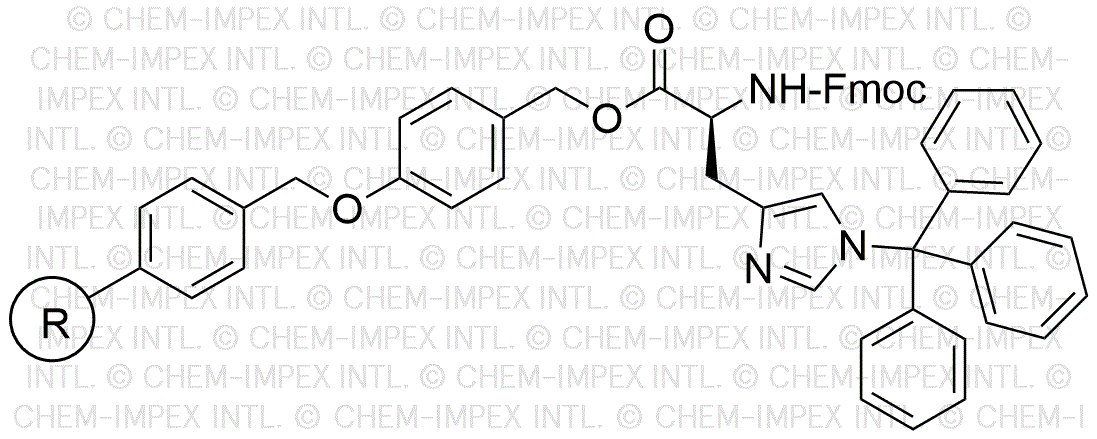Na-Fmoc-Nim-trityl-L-histidine 4-alkoxybenzyl alcohol is widely utilized in research focused on:
- Peptide Synthesis: This compound serves as a protecting group in the synthesis of peptides, allowing for selective reactions without interfering with other functional groups. This is crucial in developing complex peptides for pharmaceuticals.
- Drug Development: Its application in drug formulation helps in enhancing the stability and solubility of active pharmaceutical ingredients, making it valuable in the pharmaceutical industry for creating effective medications.
- Bioconjugation: The compound is used in bioconjugation processes, where it facilitates the attachment of drugs to antibodies or other biomolecules, improving targeted delivery systems in cancer therapy.
- Research in Biochemistry: It plays a significant role in biochemistry research, particularly in studying protein interactions and functions, which is essential for understanding various biological processes.
- Material Science: The compound can be utilized in the development of smart materials, where its unique properties contribute to creating responsive systems for sensors and drug delivery applications.
General Information
Properties
Safety and Regulations
Applications
Na-Fmoc-Nim-trityl-L-histidine 4-alkoxybenzyl alcohol is widely utilized in research focused on:
- Peptide Synthesis: This compound serves as a protecting group in the synthesis of peptides, allowing for selective reactions without interfering with other functional groups. This is crucial in developing complex peptides for pharmaceuticals.
- Drug Development: Its application in drug formulation helps in enhancing the stability and solubility of active pharmaceutical ingredients, making it valuable in the pharmaceutical industry for creating effective medications.
- Bioconjugation: The compound is used in bioconjugation processes, where it facilitates the attachment of drugs to antibodies or other biomolecules, improving targeted delivery systems in cancer therapy.
- Research in Biochemistry: It plays a significant role in biochemistry research, particularly in studying protein interactions and functions, which is essential for understanding various biological processes.
- Material Science: The compound can be utilized in the development of smart materials, where its unique properties contribute to creating responsive systems for sensors and drug delivery applications.
Documents
Safety Data Sheets (SDS)
The SDS provides comprehensive safety information on handling, storage, and disposal of the product.
Product Specification (PS)
The PS provides a comprehensive breakdown of the product’s properties, including chemical composition, physical state, purity, and storage requirements. It also details acceptable quality ranges and the product's intended applications.
Certificates of Analysis (COA)
Search for Certificates of Analysis (COA) by entering the products Lot Number. Lot and Batch Numbers can be found on a product’s label following the words ‘Lot’ or ‘Batch’.
*Catalog Number
*Lot Number
Certificates Of Origin (COO)
This COO confirms the country where the product was manufactured, and also details the materials and components used in it and whether it is derived from natural, synthetic, or other specific sources. This certificate may be required for customs, trade, and regulatory compliance.
*Catalog Number
*Lot Number
Safety Data Sheets (SDS)
The SDS provides comprehensive safety information on handling, storage, and disposal of the product.
DownloadProduct Specification (PS)
The PS provides a comprehensive breakdown of the product’s properties, including chemical composition, physical state, purity, and storage requirements. It also details acceptable quality ranges and the product's intended applications.
DownloadCertificates of Analysis (COA)
Search for Certificates of Analysis (COA) by entering the products Lot Number. Lot and Batch Numbers can be found on a product’s label following the words ‘Lot’ or ‘Batch’.
*Catalog Number
*Lot Number
Certificates Of Origin (COO)
This COO confirms the country where the product was manufactured, and also details the materials and components used in it and whether it is derived from natural, synthetic, or other specific sources. This certificate may be required for customs, trade, and regulatory compliance.

